
Edward Winter
The group photograph of Nottingham, 1936 is one of the most frequently reproduced illustrations in chess history. Another picture taken during the event (Lasker playing golf) was given in C.N. 3474:

Below are some more, beginning with Alekhine in the first round (his lapsus manus opening against Flohr):
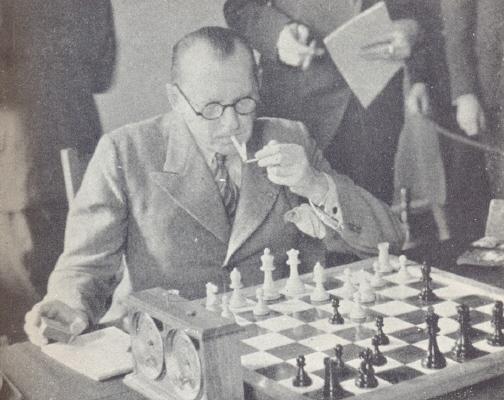
That picture is relatively well known, having been published, for instance, on page 16 of Chess Review, April 1946 and in The Treasury of Chess Lore by Fred Reinfeld (New York, 1951).
From page 48 of Evans on Chess by Larry
Evans (New York, 1974):
‘The “lapsus manus” variation derives its name from a slip of the hand made by world champion Alexander Alekhine in defense of his title.
Alekhine v Euwe, 5th match game 1935: 1 e4 e6 2 d4 d5 3 Nc3 Bb4 4 Ne2!? dxe4. Alekhine unintentionally moved his knight, sacrificing a pawn; but it turned out to be playable after 5 a3, and a new line was born.’
In fact, the ‘new line’ was already familiar, not to say famous. Alekhine played 4 Ne2 in his celebrated miniature against Nimzowitsch at Bled, 1931 – see page 94 of the second volume of his best games. There is no reason to believe it was a slip of the hand on either occasion.
Mr Evans is no doubt thinking of 1 e4 e6 2 d4 d5 3 Nc3 Bb4 4 Bd2 (Alekhine-Flohr, Nottingham, 1936), which Alekhine admitted, on page 17 of the tournament book, was a ‘lapsus manus’.
(1598)
Alekhine’s note to 4 Bd2:
‘A “lapsus manus”. I intended to play 4 P-K5 and P-B4, as, for instance, against Nimzowitsch at San Remo, 1930, but instead I made the move with the bishop first.’
A photograph of Alekhine in play against Euwe was given on page 229 of the October 1936 Chess Review.
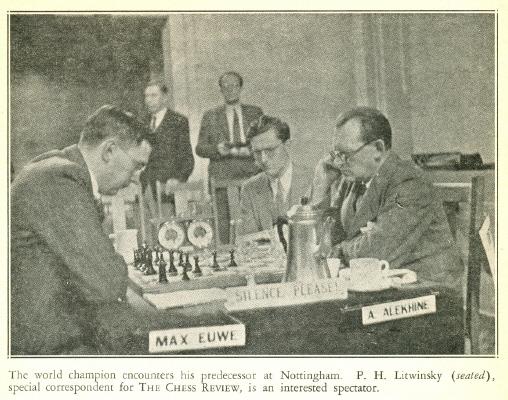
P.H. Litwinsky was later known as Paul Hugo Little.
Another photograph of the playing hall comes from page 201 of the September 1936 Chess Review:
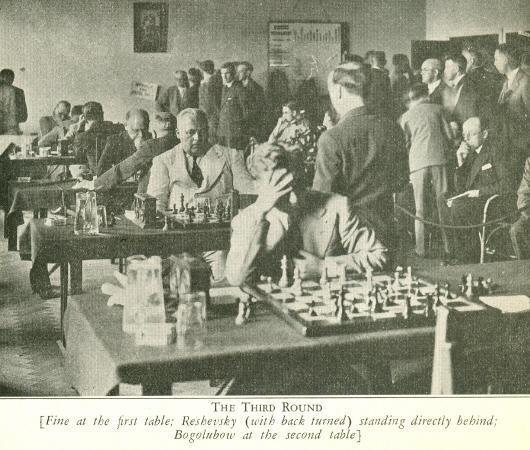
Savielly Tartakower and Sir George Thomas were featured on page 20 of CHESS, 14 September 1936:
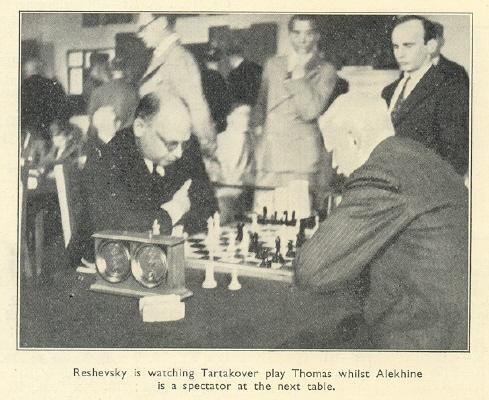
Botvinnik, in play against Alexander, was shown on page 2 of the same issue:
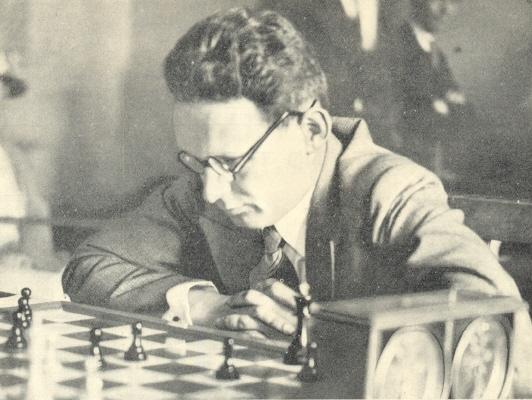
A further picture is currently available to us only in a poor-quality version from a scrapbook (Capablanca v Bogoljubow):

After Capablanca died, page 98 of the April 1942 CHESS printed a photograph of Capablanca in Nottingham with H.G.T. Matchett:
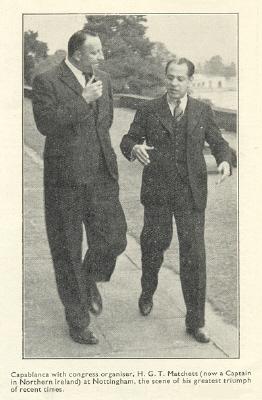
Four outdoor photographs of the masters were published in the Chess Review, September 1936 (pages 200, 203, 204 and 211):

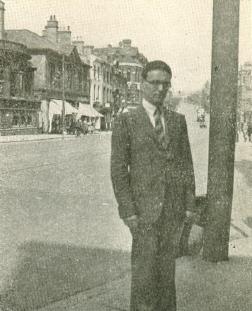
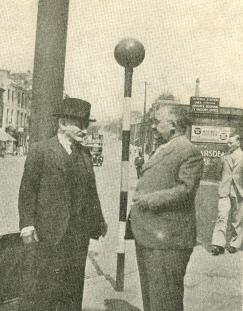
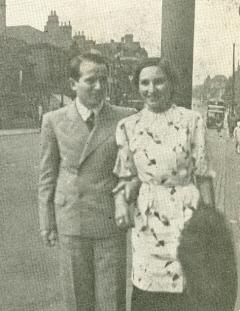
Left to right: José Raúl Capablanca, Mikhail Botvinnik, Emanuel Lasker and Milan Vidmar, Salo Flohr and his wife.
Page 7 of CHESS, 14 September 1936 had a picture of the wives of Euwe, Botvinnik and Flohr:
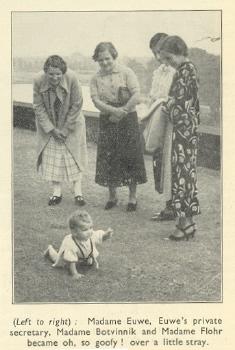
Finally, the following group shot appeared opposite page 481 of the October 1936 BCM:
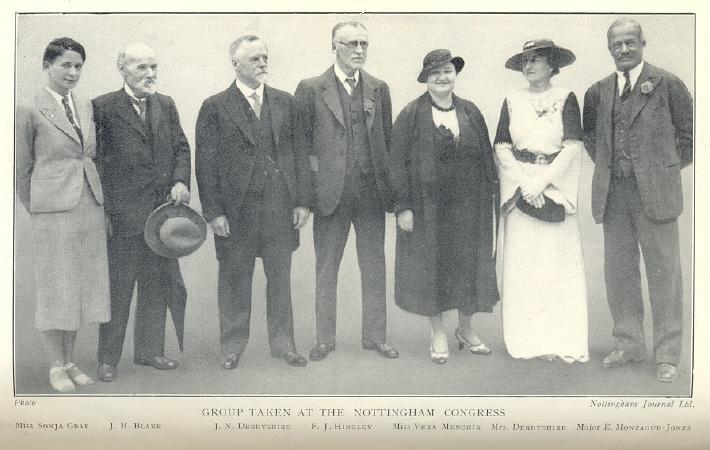
Did any local newspapers of the time have further photographs?
(4935)
The Nottingham, 1936 tournament book was dedicated to Alderman Job Nightingale Derbyshire (1866-1954), an exceptional chess patron who was the key figure behind the event. Below are two portraits of him:
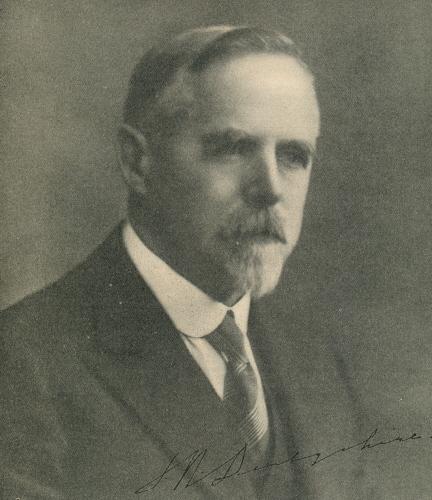
J.N. Derbyshire (CHESS, 14 September 1936, page 9)

J.N. Derbyshire (British Chess Federation Year Book 1938-1945, page 2.)
(6163)
Olimpiu G. Urcan (Singapore) has forwarded an illustrated report on page 10 of the Nottingham Evening Post, 6 August 1936.
(7625)
We seek copies of better quality of three additional photographs:
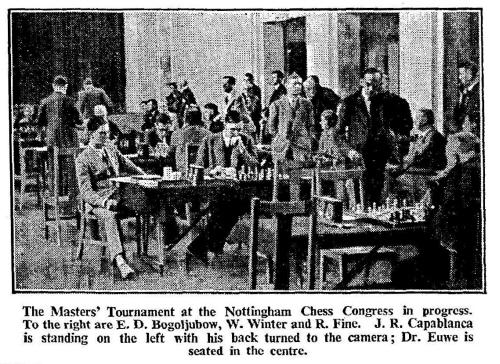
The Times, 26 August 1936, page 9

The Times, 29 August 1936, page 8
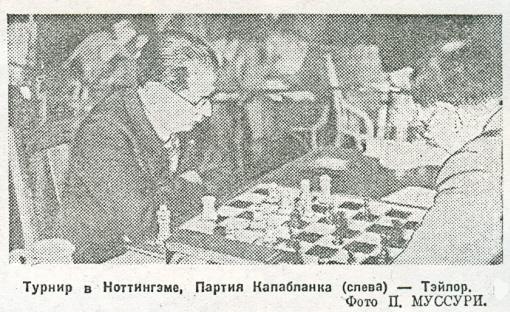
The famous group photograph:
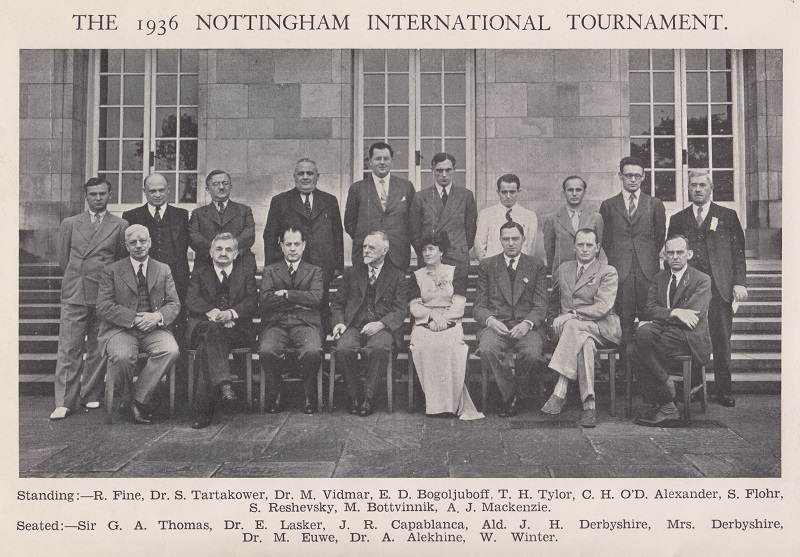
The above version appeared in the tournament book edited by W.H. Watts. (The initials of Alderman Derbyshire were J.N., and not J.H., a mistake widely copied in books, magazines and on the Internet.)
Pages 135-140 of Emanuel Lasker edited by R. Forster, M. Negele and R. Tischbierek (Berlin, 2018) present an excellent set of photographs taken at Nottingham, 1936, from the Lothar Schmid Collection.
Leonard Barden (London) asks whether it is known why Nottingham, 1936 had an odd number of players (15), a bye therefore being required in each round. (In passing, Mr Barden mentions that he met over the board nine of the 15 participants, and had some slight contact with another three.)
So far, we have found no suggestion that an even number of players was ever intended in the Nottingham tournament, or that byes were considered undesirable. At present, we can do no better than offer an overview of how the tournament came about, based on accounts in English-language chess magazines of the time. The reports consulted indicate that 15 was the only figure that the organizers ever envisaged.
Page 363 of the August 1935 BCM announced an appeal for funds to hold an International Chess Congress in Nottingham the following year, including a ‘Masters’ Invitation Tournament’ in which the world champion (Alekhine) and his two predecessors (Capablanca and Lasker) ‘have definitely agreed to compete’. The Council of the Nottingham University had offered College buildings as the venue, and the support of the Lord Mayor and Corporation of Nottingham had been secured. The estimated net cost of the Congress was £2,200. The President of the Nottinghamshire Chess Association, J.N. Derbyshire, had offered to pay half of the net total, to commemorate a Nottingham tournament in which he had participated in 1886. The British Chess Federation was called upon to respond in equal measure, and an appeal for funds was launched.
Page 405 of the September 1935 BCM stated that Sir George Thomas would give a simultaneous display at each chess club which subscribed at least two guineas to the fund, and the following month (page 466) the BCM reported that the response to the appeal had been generous and that a meeting of the Executive Committee of the British Chess Federation on 19 October would decide whether the full programme could go ahead. As reported on page 495 of the November 1935 BCM, a positive decision was taken by the Executive Committee, given that by the time of its meeting about £800 of the required £1,100 had been guaranteed or subscribed by donations.
An editorial on pages 161-162 of CHESS, 14 January 1936 stated that the participation of the new world champion, Euwe, was uncertain because of his professional duties, and that Flohr might also be absent, owing to military service commitments.
The following month (14 February 1936 issue, page 201) CHESS wrote:
‘At the 25 January meeting of the British Chess Federation, definite plans were put in hand for Nottingham. Dr Max Euwe, world champion, will compete, and the participation of Alexander Alekhine, José Raoul Capablanca and Dr Lasker is practically certain. Each will receive travelling expenses and £200 “appearance money”; the other participants will receive travelling expenses and donations towards their hotel expenses. ... Among the 15 competitors, four will be British. A list – provisional, and liable to modification – of ten candidates for the remaining seven places open to players from abroad has been drawn up. Whilst details of this list can naturally not be lightly divulged, our American cousins can take it that it includes the names of Reuben Fine and Samuel Reshevsky.
Since several masters of high standing may have to be excluded, willy nilly, from the premier tournament, the prizes in the second tournament are to be substantial.’
Page 9 of the January 1936 American Chess Bulletin commented:
‘The United States will be represented by one or two experts, and, in this connection, Samuel Reshevsky and Reuben Fine, both of New York, winners of the tournaments at Margate and Hastings, respectively, are favorably mentioned. Isaac I. Kashdan, another New Yorker, is also regarded as having strong claims for consideration.’
The 14 February 1936 issue of CHESS, pages 201-202, accused Capablanca of stirring up unnecessary difficulties by insisting that Euwe, though an amateur, should demand an appearance fee, but the claim was denied by Euwe himself. From pages 272-273 of the 14 March 1936 CHESS:
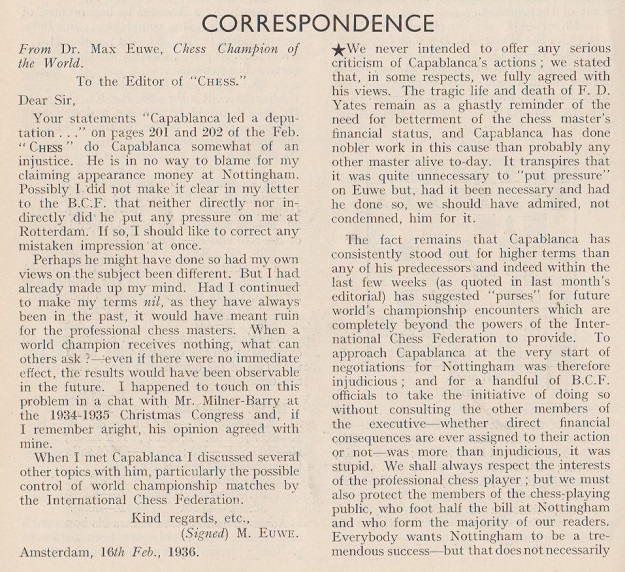
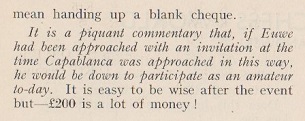
In a letter published on page 315 of the 14 April 1936 issue of CHESS P.S. Milner-Barry confirmed Euwe’s recollection of their conversation in Hastings in 1935.
Page 17 of the January 1936 BCM stated: ‘Before long now the remaining invitations to participate will be issued, the exact date fixed and the supplementary programme completed.’ The following month (pages 73-74), the BCM wrote:
‘The fateful meeting of the Committee of the British Chess Federation was held on 25 January, when the final arrangements were made and the names of the masters selected for invitation.’
No names were printed, but page 120 of the March 1936 BCM stated:
‘The BCF Executive Committee announce that the Masters’ tournament at Nottingham will commence on 10 August and will continue until the 28th. It will consist of 15 competitors, of whom five will be British players, and it is hoped Sultan Khan will be one, and the prize list will be: 1st £200, 2nd £150, 3rd £100, 4th £75, while not less than £200 will be awarded to those competitors who do not win a prize, in the ratio of their final score.’
Details of the plans for other events in the Congress were given, and the report concluded (page 121): ‘The Congress will be held in Nottingham University College. There is to be no charge for admission to see the play.’
Page 223 of the May 1936 BCM reported:
‘Arrangements for the Nottingham Congress are proceeding satisfactorily, and on the 2nd instant the Executive Committee will review and settle the full compositions of the Masters’ Tournament, and the details in connection with the general Congress will then be available for publication.’
On page 275 of the June 1936 BCM, the participants in the Masters’ tournament were announced as follows:
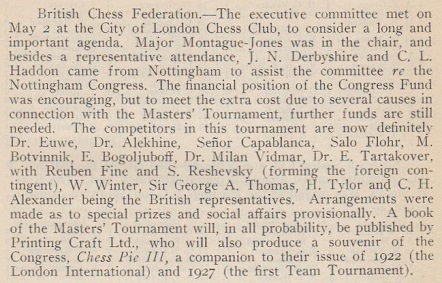
Lasker’s name was omitted, but it was included in the list on page 325 of the 14 May 1936 CHESS, which added some opinions on the selections made:
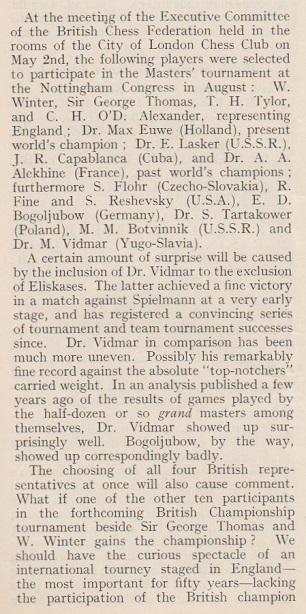

The British championship (Bournemouth, June 1936) was won by William Winter.
From page 365 of the August 1936 BCM:
‘We are advised by the Secretary of the British Chess Federation that all the masters have confirmed their acceptance to the BCF invitation ...’
Some observations on the choice of the British contingent appeared on pages 51-52 of Chess Pie No. 3, but details about the selection method for Nottingham, 1936 are sparse. Have any of the British Chess Federation’s archives, and particularly minutes of meetings in the mid-1930s, survived?
It is, for instance, unclear what role in the selection process was played by the fact that the Nottingham tournament clashed with the Munich International Team Tournament (in which both Eliskases and Keres participated). From page 362 of the 14 June 1936 CHESS:
‘Since, as the Deutsche Schachzeitung puts it, “the trouble of trying to get the English people to bring the date of the Nottingham congress forward has proved unavailing”, the unofficial international team tournament at Munich is to commence, with the active support of the German Government, on the date originally mentioned for it.’
This referred to a passage about the Munich event on page 129 of the May 1936 Deutsche Schachzeitung:
‘Die Bemühungen, die Engländer zu einer Vorverlegung des Nottinghamer Turniers zu bewegen, sind ohne Erfolg geblieben, und der Beginn der Münchner Veranstaltungen ist daher jetzt auf den 16. August, wie ursprünglich beabsichtigt, festgesetzt worden.’
Chess Pie remarked (page 38) in connection with the world championship:
‘Never before in chess history have four men who have held the title been alive at one time, and the present four [Euwe, Alekhine, Capablanca and Lasker] have never all met in the same tournament.’
Below is a picture from page 12 of the Aberdeen Press and Journal, 27 August 1936:
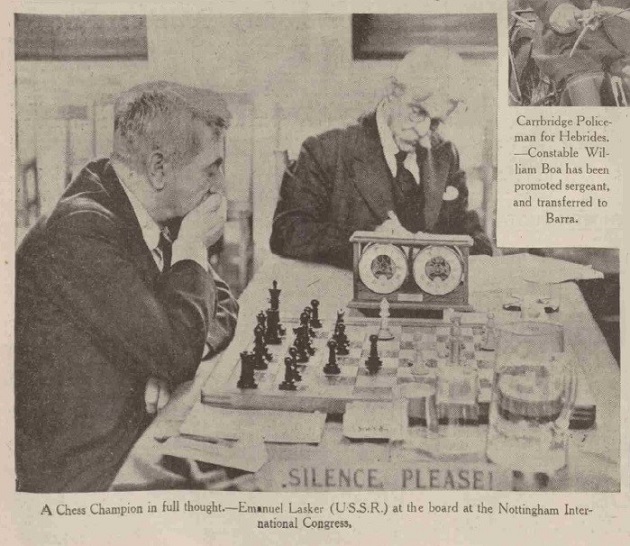
A cropped version was published opposite page 80 of Kings of Chess by William Winter (London, 1954).
(9646)
To the Chess Notes main page.
To the Archives for other feature articles.
Copyright: Edward Winter. All rights reserved.